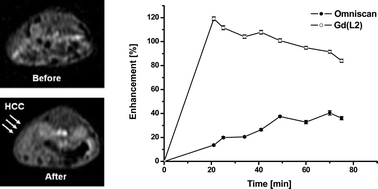Gd-complexes of DTPA-bis(amide) conjugates of tranexamic acid and its esters with high relaxivity and stability for magnetic resonance imaging
Abstract
The synthesis and the characterization of a series of DTPA-bis(amide) conjugates of

* Corresponding authors
a
Department of Applied Chemistry, Kyungpook National University, Daegu, Korea
E-mail:
tjkim@knu.ac.kr
Fax: +82-53-950-6594
Tel: +82-53-950-5587
b
Department of Medical & Biological Engineering, Kyungpook National University, Daegu, Korea
E-mail:
ychang@knu.ac.kr
Fax: +82-53-422-2677
Tel: +82-53-420-5471
c Department of Biology, Kyungpook National University, Daegu, Korea
d Department of Diagnostic Radiology, Kyungpook National University, Daegu, Korea
e Department of Molecular Medicine, Kyungpook National University, Daegu, Korea
The synthesis and the characterization of a series of DTPA-bis(amide) conjugates of

 Please wait while we load your content...
Something went wrong. Try again?
Please wait while we load your content...
Something went wrong. Try again?
S. Dutta, J. Park, J. Jung, Y. Chang and T. Kim, Dalton Trans., 2008, 2199 DOI: 10.1039/B719440D
To request permission to reproduce material from this article, please go to the Copyright Clearance Center request page.
If you are an author contributing to an RSC publication, you do not need to request permission provided correct acknowledgement is given.
If you are the author of this article, you do not need to request permission to reproduce figures and diagrams provided correct acknowledgement is given. If you want to reproduce the whole article in a third-party publication (excluding your thesis/dissertation for which permission is not required) please go to the Copyright Clearance Center request page.
Read more about how to correctly acknowledge RSC content.
 Fetching data from CrossRef.
Fetching data from CrossRef.
This may take some time to load.
Loading related content
